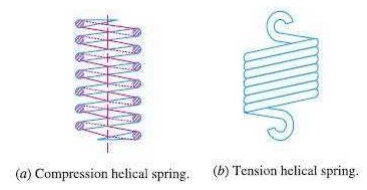Chapter: Mechanical : Design of Machine Elements : Design of Energy Storing Elements
Design of Energy Storing Elements
DESIGN OF
ENERGY STORING ELEMENTS
SPRINGS
A spring is defined as an elastic body, whose
function is to distort when loaded and to recover its original shape when the
load is removed. The various important applications of springs are as follows:
To cushion, absorb or control energy due to either
shock or vibration as in car springs, railway buffers, air-craft landing gears,
shock absorbers and vibration dampers.
To apply forces, as in brakes, clutches and spring
loaded valves.
To control motion by maintaining contact between
two elements as in cams and followers.
To measure forces, as in spring balances and engine
indicators.
To store energy, as in watches, toys, etc.
Types of
Springs:
Though there are many types of the springs, yet the
following, according to their shape, are important from the subject point of
view.
1. Helical
springs.
The
helical springs are made up of a wire coiled in the form of a helix and is
primarily intended for compressive or tensile loads. The cross-section of the
wire from which the spring is made may be circular, square or rectangular. The
two forms of helical springs are compression helical spring as shown
in Fig (a) and tension helical spring as shown
in Fig (b).

The helical springs are said to be closely
coiled when the spring wire is coiled so close that the plane containing each
turn is nearly at right angles to the axis of the helix and the wire is
subjected to torsion. In other words, in a closely coiled helical spring, the
helix angle is very small, it is usually less than 10°. The major stresses
produced in helical springs are shear stresses due to twisting. The load
applied is parallel to or along the axis of the spring.
In open
coiled helical springs, the spring wire is coiled in such a way that there
is a gap between the two consecutive turns, as a result of which the helix
angle is large. Since the application of open coiled helical springs are
limited, therefore our discussion shall confine to closely coiled helical springs
only.
The
helical springs have the following advantages:
These are easy to manufacture.
These are available in wide range.
These are reliable.
These have constant spring rate.
Their performance can be predicted more accurately.
Their characteristics can be varied by changing
dimensions.
2. Conical
and volute springs.
The
conical and volute springs, as shown in Fig., are used in special applications
where a telescoping spring or a spring with a spring rate that increases with
the load is desired. The conical spring, as shown in Fig(a), is wound with a
uniform pitch whereas the volute springs, as shown in Fig (b), are wound in the
form of paraboloid with constant pitch and lead angles. The springs may be made
either partially or completely telescoping. In either case, the number of
active coils gradually decreases. The decreasing number of coils results in an
increasing spring rate. This characteristic is sometimes utilised in vibration
problems where springs are used to closely coiled helical springs only.support
a body that has a varying mass.

The major
stresses produced in conical and volute springs are also shear stresses due to
twisting.
3. Torsion
springs.
These springs may be of helical or spiral type as shown in Fig. The helical
type may be
used only in applications where the load tends to wind up the spring and are
used in various electrical mechanisms.

The spiral type is also used where the load
tends to increase the number of coils and when made of flat strip are used in
watches and clocks.The major stresses produced in torsion springs are tensile
and compressive due to bending.
4.
Laminated or leaf springs.
The laminated or leaf spring (also known as flat
spring or carriage spring)
consists of a number of flat plates (known as leaves) of varying lengths held
together by means of clamps and bolts, as shown in Fig. These are mostly used
in automobiles.

The major
stresses produced in leaf springs are tensile and compressive stresses.
5. Disc or
bellevile springs.
These springs consist of a number of conical discs
held together against slipping by a central bolt or tube as shown in Fig. These
springs are used in applications where high spring rates and compact spring
units are required.

6. Special
purpose springs.
These springs are air or liquid springs, rubber
springs, ring springs etc. The fluids (air or liquid) can behave as a
compression spring. These springs are used for special types of application
only
.
Material
for Helical Springs
The
material of the spring should have high fatigue strength, high ductility, high
resilience and it should be creep resistant. It largely depends upon the
service for which they are used i.e. severe service, average service or light
service.
Severe service means
rapid continuous loading where the ratio of minimum to maximum load (or
stress) is one-half or less, as in automotive valve springs.
Average service includes
the same stress range as in severe service but with only intermittent
operation, as in engine governor springs and automobile suspension springs.
Light service includes springs subjected to
loads that are static or very infrequently varied, as in safety valve springs.
Related Topics